A reader asks, “I recently read your review of Tata Nifty Midcap 150 Momentum 50 Index Fund. I wondered if tactical entry and exit with your double-moving average market timing model will provide better results than systematic investing with a momentum index fund. Can you please backtest this?”
We can certainly backtest it, but India’s history of momentum indices is quite short. The inception date of the two NSE momentum indices is only 1st April 2005. The traded data is much shorter.
Also, longer history does not matter much with systematic or tactical investing (aka market timing). There are always new risks emerging. See: A risk in market timing that 122 years of backtesting failed to reveal!
Warning and disclaimer: The strategy outlined in this article and links therein may or may not provide a higher return when you try it. Our backtests reveal that this strategy has a higher risk than systematic investing. It may not always provide a higher reward for the higher risk taken. So users must appreciate this before considering this strategy.
Please recognise results shown in backtests do not factor in future market movements, human emotions, taxation and exit loads. All these would impact the outcome of market timing (aka tactical asset allocation wrt this tool).
Join 32,000+ readers and get free money management solutions delivered to your inbox! Subscribe to get posts via email! (Link takes you to our email sign-up form)
🔥Want to create a complete financial plan? Learn goal-based investing? Exclusive access to our DIY tools? Increase your income with your skills? Enjoy massive discounts on our robo-advisory tool & courses! 🔥
Not all asset allocation variations and investment durations were considered in our backtests. Past and future results will depend on and vary according to the asset allocation mix and investment duration considered. For example, for equity, the model works reasonably well with 50% equity or lower equity (rest in fixed income) and not so well for higher equity allocations.
Our backtests indicate that the model fails for sharp price changes (up or down, e.g. the March 2020 market crash) and the following sequence of returns. No single strategy would work for all markets and at all times.
Anyone who uses this strategy or the associated tool does so at their own risk. Freefincal or this author/editor is not responsible or liable for any gains or losses resulting from this strategy or tool.
The data: We shall use Nifty Midcap 150 Momentum 50 Total Returns Index data. For debt, we shall assume the availability of an instrument offering 6% a year post-tax.
Asset allocation: 50% equity and 50% debt. Results will depend on the asset allocation used.
Systematic investing: A sum is invested each month in equity and debt. We shall consider 50% equity and 50% debt over three, seven, and ten years. The portfolio is rebalanced annually. Taxes and exit loads due to this are not considered.
Tactical investing: If the six -months moving average (6MMA) of the equity index is greater than the 12-month moving average (12MMA), then all debt holdings are sold and invested in equity. All future investments are also made in equity.
If 6MMA < 12 MMA, all equity holdings are sold and invested in debt. All future investments are also made in debt. Tax and exit load due to the switches are not considered. However, typically the average number of switches is lesser than annual rebalancing. For example, the no of buy/sell switches over 5 years is only about twice on average. Over seven years, it is only three on average. The buy/sell signal and the moving averages are shown below.
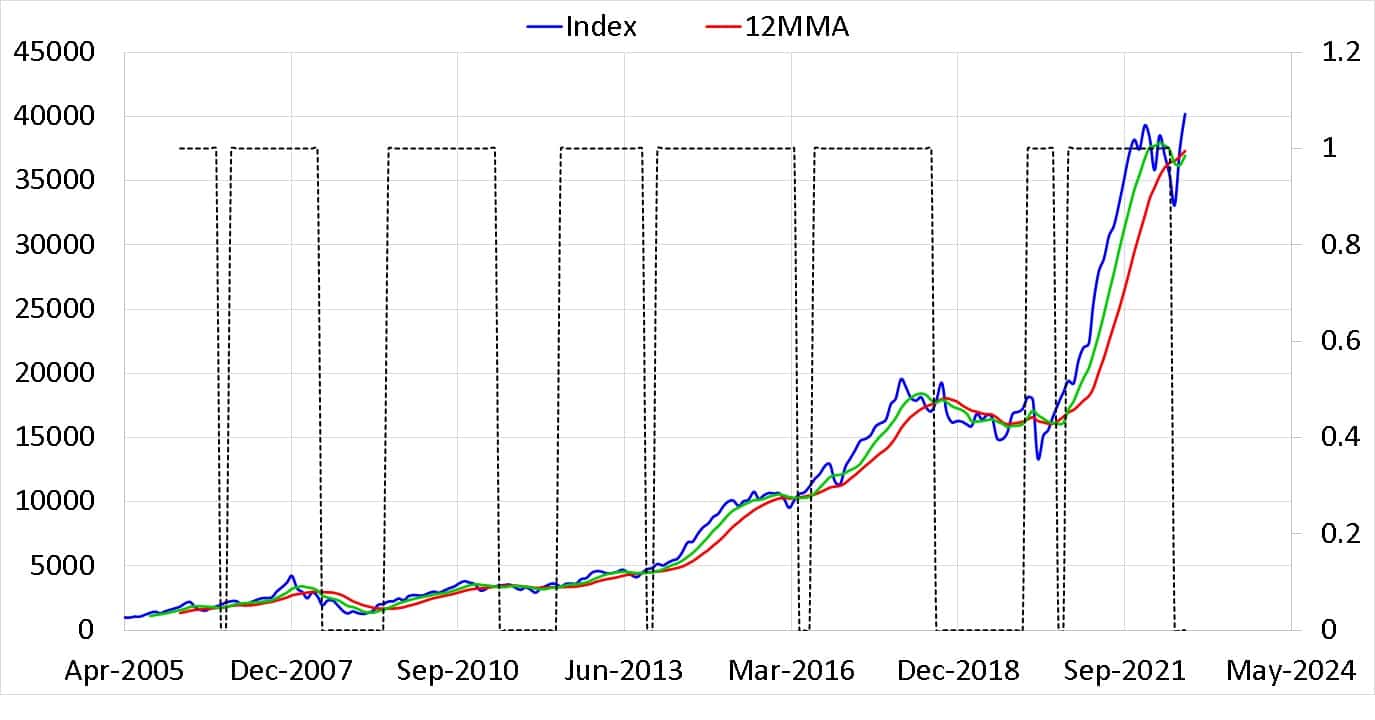
This is an example of a single backtest over the last 15Y. It is important not to get carried away with this as it is just one run.
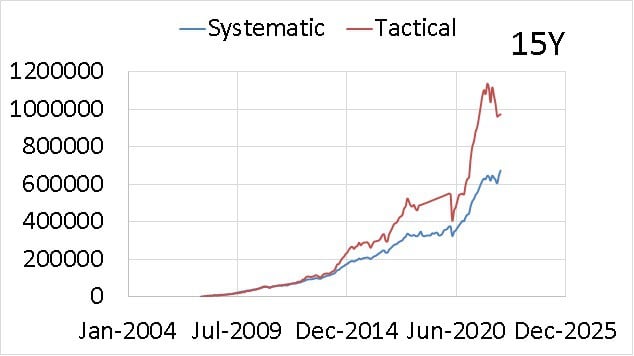
Five years:
- No of runs: 150

- Top left panel: the XIRR. For the period studied, the tactical strategy has done quite well.
- Top right panel: The portfolio’s maximum drawdown (max fall from peak) is shown (less negative, the better). The tactical strategy often has a higher drawdown. That is a higher risk.
- Bottom left panel: The standard deviation or volatility (lower the better). The tactical approach has higher volatility.
- Bottom right panel: the max no of months the portfolio was below its peak or underwater (lower the better). Often the tactical strategy takes longer to recover.
It must be understood that the results depend on the asset allocation chosen. For example, the above is 50% equity and 50% debt. If we change this to 70% equity and 30% equity, then the five-year results look like this.
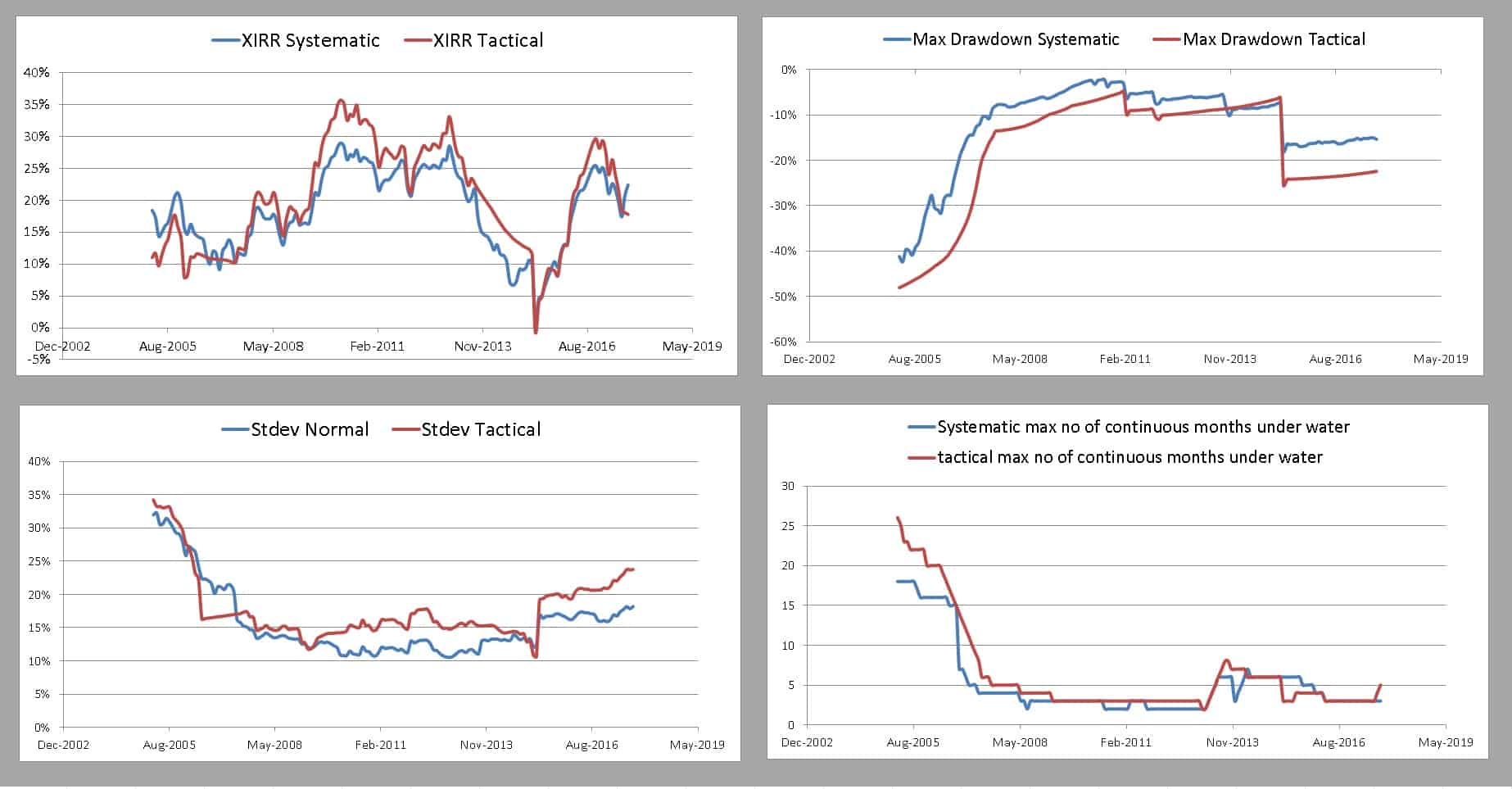
Notice that the margin of outperformance of the tactical strategy has significantly reduced. The tactical strategy is less rewarding compared to the 50:50 allocation. The higher risk associated with the tactical strategy has also decreased. This pattern is also observed over 7 and 10 years. This is a key feature that must always be kept in mind.
50% Equity and 50% debt over seven years (126 intervals)
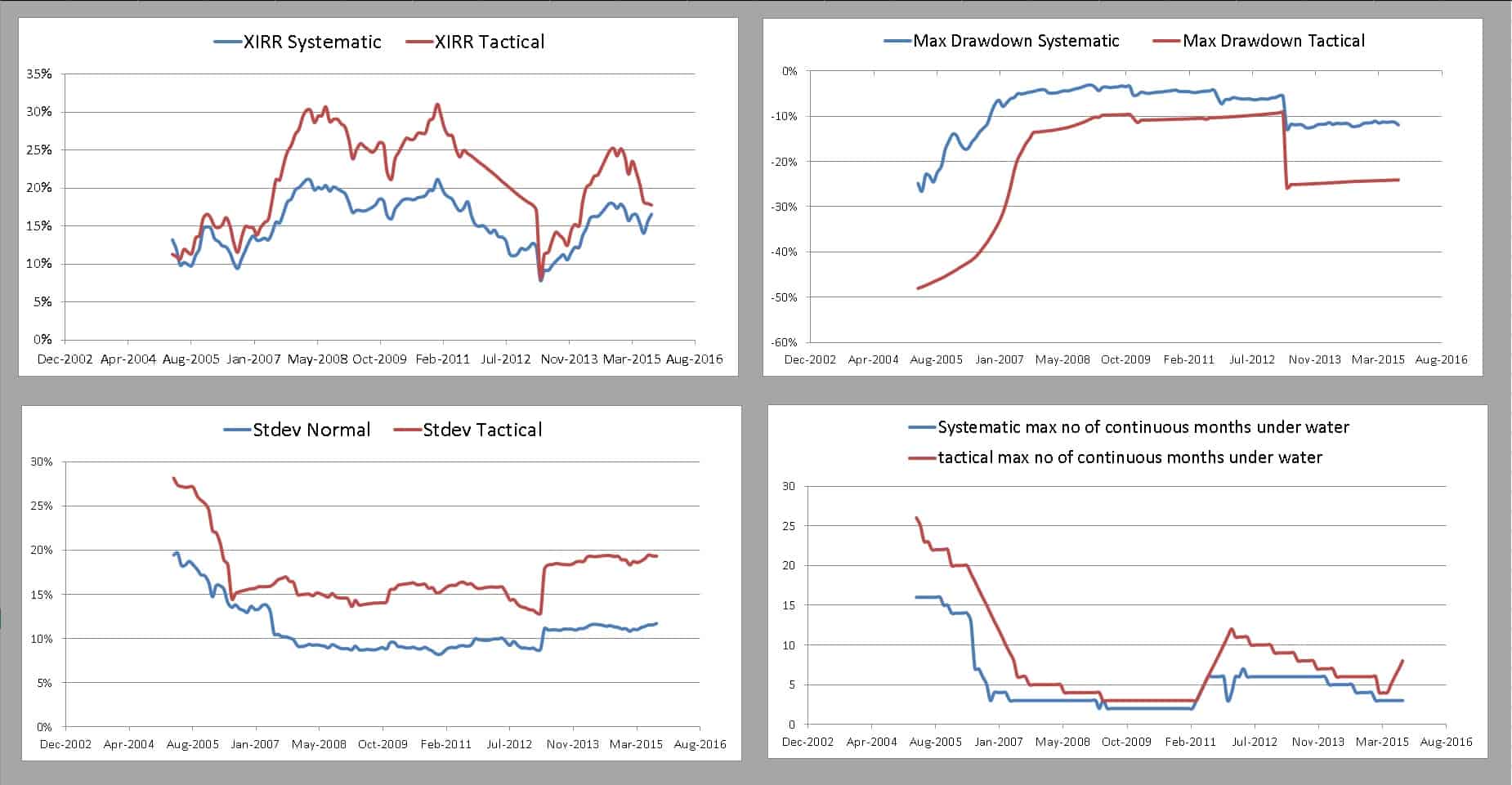
70% Equity and 30% debt over seven years (126 intervals)
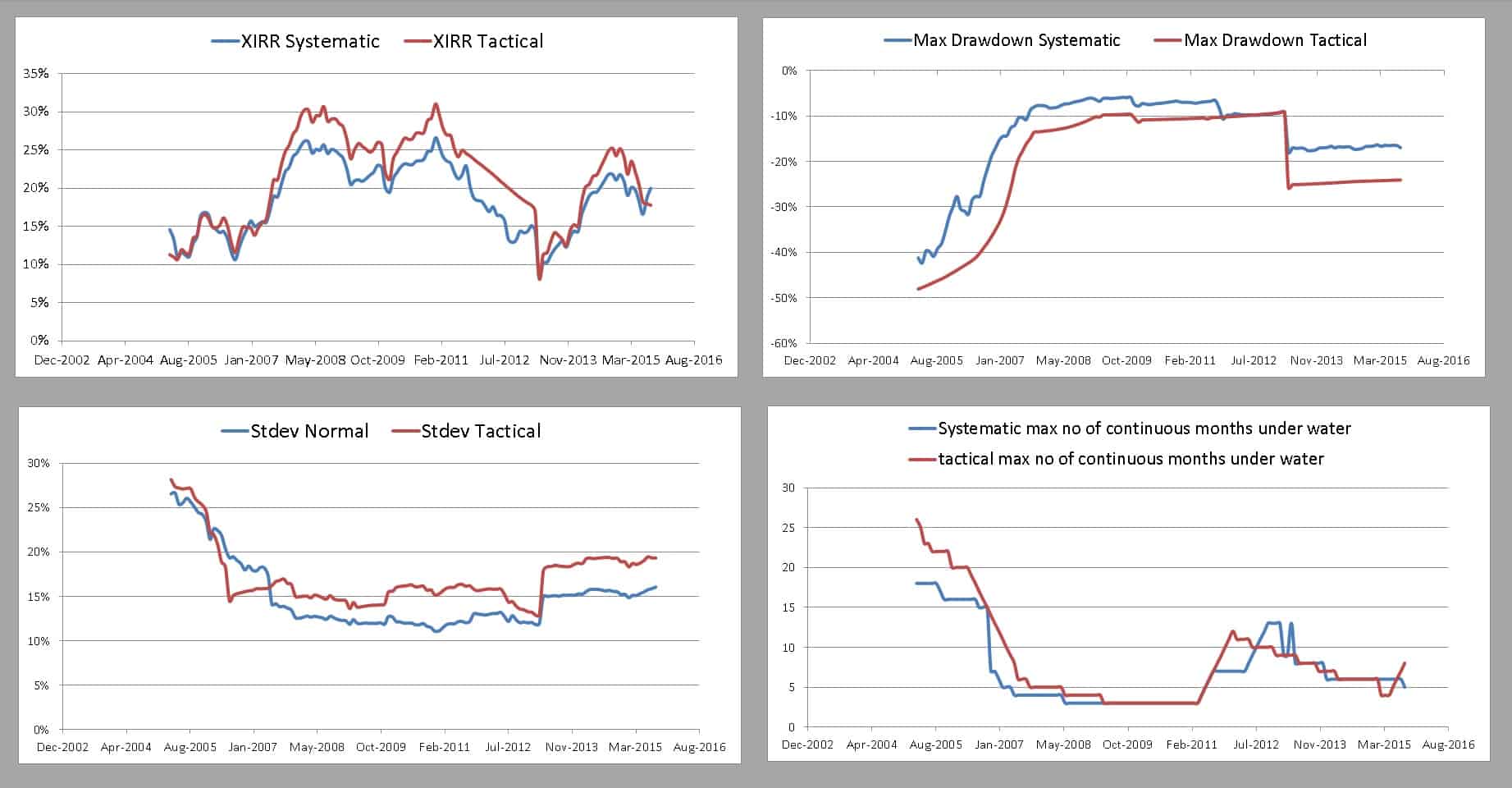
50% Equity and 50% debt over ten years (90 intervals)
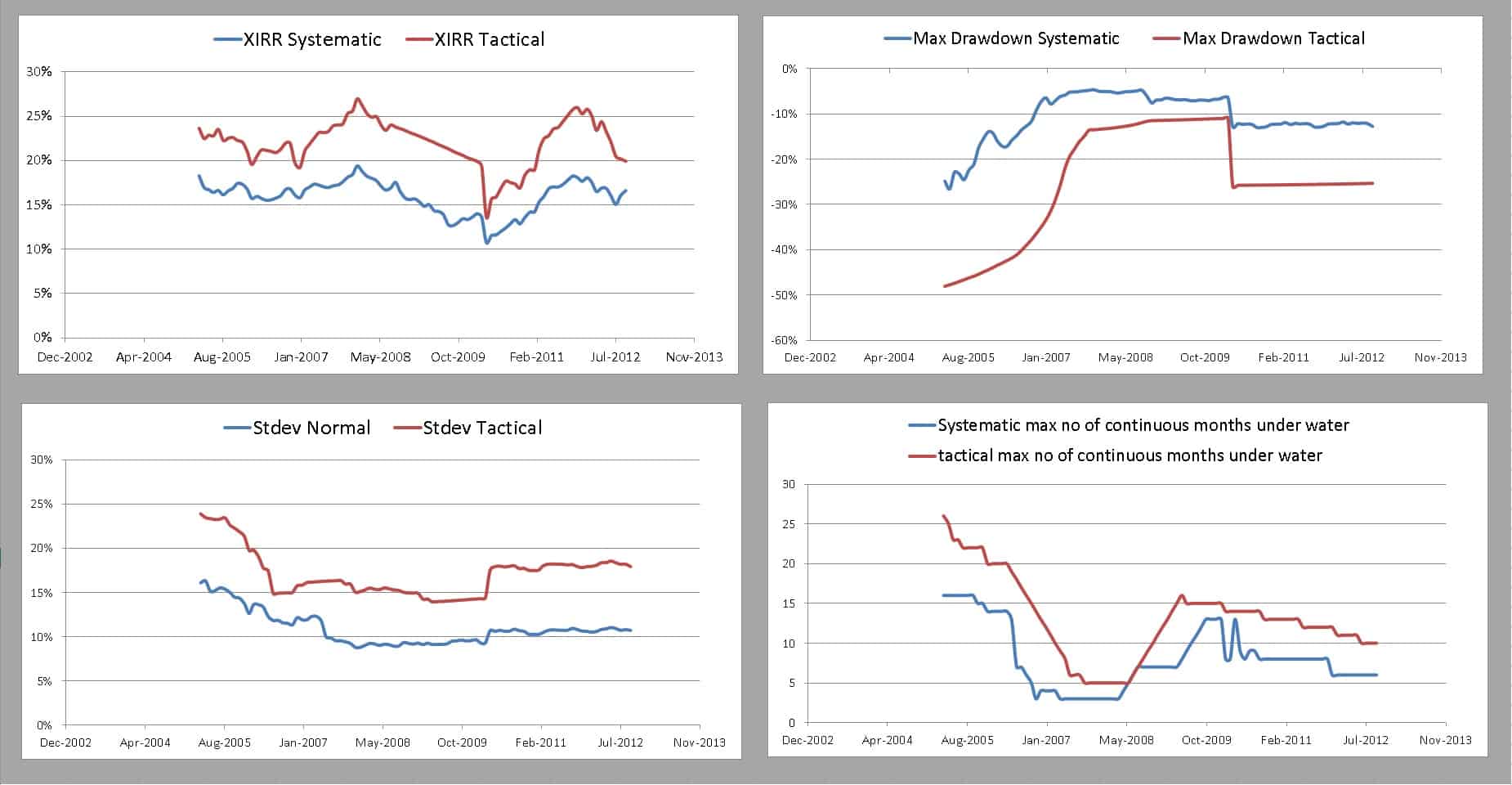
70% Equity and 30% debt over ten years (90 intervals)
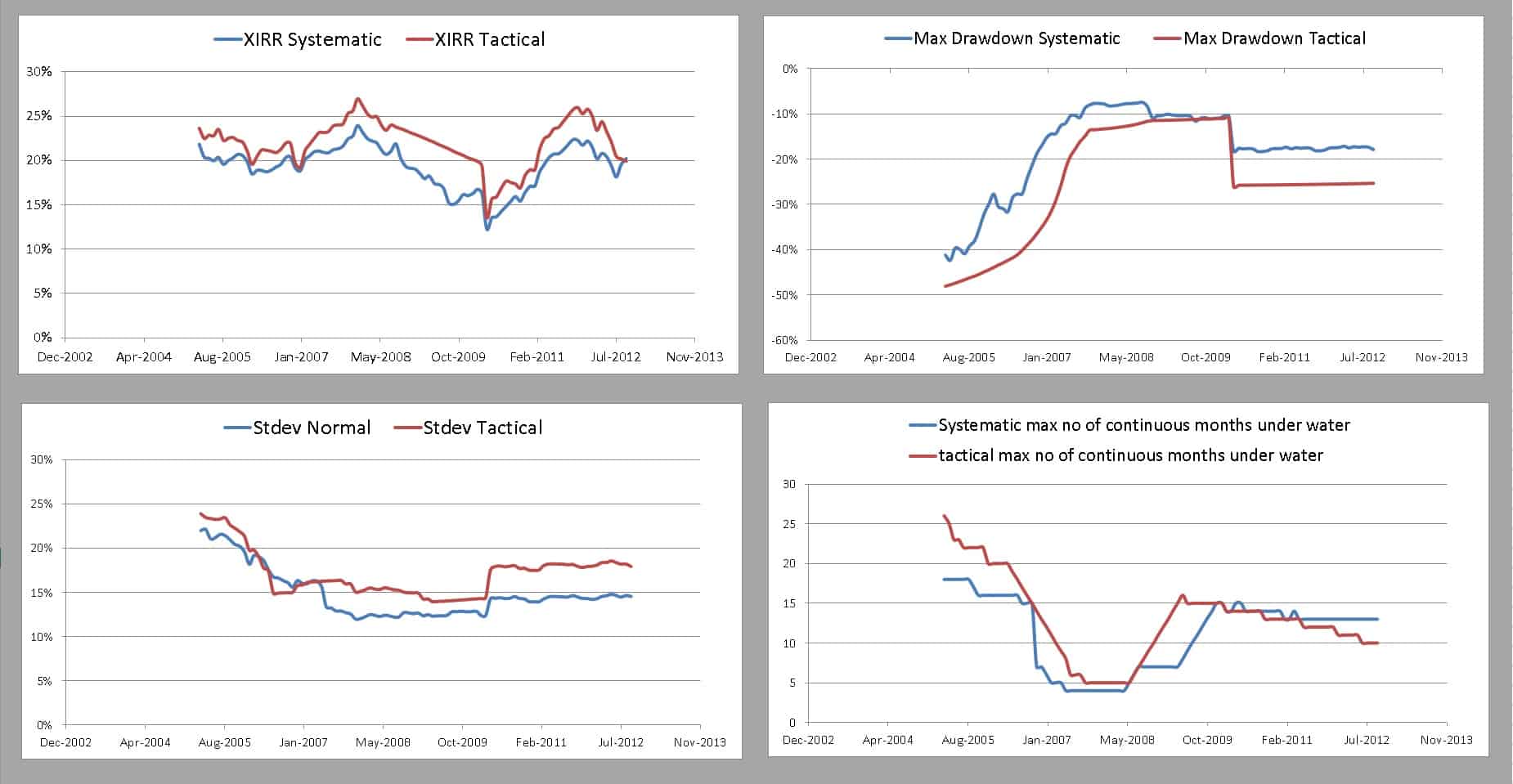
Results of the double-moving average market timing model applied to a momentum index do seem promising. However, it must be understood that the model may not work well with sudden and sharp index movements. Those with small exposure to a momentum index or a small cap fund can consider the strategy after appreciating its risks. See: Do not use SIPs for Small Cap Mutual Funds: Try this instead!
🔥Enjoy massive discounts on our courses, robo-advisory tool and exclusive investor circle! 🔥& join our community of 7000+ users!
Use our Robo-advisory Tool for a start-to-finish financial plan! ⇐ More than 2,500 investors and advisors use this!
Track your mutual funds and stock investments with this Google Sheet!
We also publish monthly equity mutual funds, debt and hybrid mutual funds, index funds and ETF screeners and momentum, low-volatility stock screeners.





- Do you have a comment about the above article? Reach out to us on Twitter: @freefincal or @pattufreefincal
- Have a question? Subscribe to our newsletter using the form below.
- Hit 'reply' to any email from us! We do not offer personalized investment advice. We can write a detailed article without mentioning your name if you have a generic question.
Join 32,000+ readers and get free money management solutions delivered to your inbox! Subscribe to get posts via email! (Link takes you to our email sign-up form)
About The Author
 Dr M. Pattabiraman(PhD) is the founder, managing editor and primary author of freefincal. He is an associate professor at the Indian Institute of Technology, Madras. He has over ten years of experience publishing news analysis, research and financial product development. Connect with him via Twitter(X), Linkedin, or YouTube. Pattabiraman has co-authored three print books: (1) You can be rich too with goal-based investing (CNBC TV18) for DIY investors. (2) Gamechanger for young earners. (3) Chinchu Gets a Superpower! for kids. He has also written seven other free e-books on various money management topics. He is a patron and co-founder of “Fee-only India,” an organisation promoting unbiased, commission-free investment advice.
Dr M. Pattabiraman(PhD) is the founder, managing editor and primary author of freefincal. He is an associate professor at the Indian Institute of Technology, Madras. He has over ten years of experience publishing news analysis, research and financial product development. Connect with him via Twitter(X), Linkedin, or YouTube. Pattabiraman has co-authored three print books: (1) You can be rich too with goal-based investing (CNBC TV18) for DIY investors. (2) Gamechanger for young earners. (3) Chinchu Gets a Superpower! for kids. He has also written seven other free e-books on various money management topics. He is a patron and co-founder of “Fee-only India,” an organisation promoting unbiased, commission-free investment advice.Our flagship course! Learn to manage your portfolio like a pro to achieve your goals regardless of market conditions! ⇐ More than 3,000 investors and advisors are part of our exclusive community! Get clarity on how to plan for your goals and achieve the necessary corpus no matter the market condition is!! Watch the first lecture for free! One-time payment! No recurring fees! Life-long access to videos! Reduce fear, uncertainty and doubt while investing! Learn how to plan for your goals before and after retirement with confidence.
Our new course! Increase your income by getting people to pay for your skills! ⇐ More than 700 salaried employees, entrepreneurs and financial advisors are part of our exclusive community! Learn how to get people to pay for your skills! Whether you are a professional or small business owner who wants more clients via online visibility or a salaried person wanting a side income or passive income, we will show you how to achieve this by showcasing your skills and building a community that trusts and pays you! (watch 1st lecture for free). One-time payment! No recurring fees! Life-long access to videos!
Our new book for kids: “Chinchu Gets a Superpower!” is now available!


Must-read book even for adults! This is something that every parent should teach their kids right from their young age. The importance of money management and decision making based on their wants and needs. Very nicely written in simple terms. - Arun.Buy the book: Chinchu gets a superpower for your child!
How to profit from content writing: Our new ebook is for those interested in getting side income via content writing. It is available at a 50% discount for Rs. 500 only!
Do you want to check if the market is overvalued or undervalued? Use our market valuation tool (it will work with any index!), or get the Tactical Buy/Sell timing tool!
We publish monthly mutual fund screeners and momentum, low-volatility stock screeners.
About freefincal & its content policy. Freefincal is a News Media Organization dedicated to providing original analysis, reports, reviews and insights on mutual funds, stocks, investing, retirement and personal finance developments. We do so without conflict of interest and bias. Follow us on Google News. Freefincal serves more than three million readers a year (5 million page views) with articles based only on factual information and detailed analysis by its authors. All statements made will be verified with credible and knowledgeable sources before publication. Freefincal does not publish paid articles, promotions, PR, satire or opinions without data. All opinions will be inferences backed by verifiable, reproducible evidence/data. Contact information: To get in touch, use this contact form. (Sponsored posts or paid collaborations will not be entertained.)
Connect with us on social media
- Twitter @freefincal
- Subscribe to our YouTube Videos
- Posts feed via Feedburner.
Our publications
You Can Be Rich Too with Goal-Based Investing
 Published by CNBC TV18, this book is meant to help you ask the right questions and seek the correct answers, and since it comes with nine online calculators, you can also create custom solutions for your lifestyle! Get it now.
Published by CNBC TV18, this book is meant to help you ask the right questions and seek the correct answers, and since it comes with nine online calculators, you can also create custom solutions for your lifestyle! Get it now.Gamechanger: Forget Startups, Join Corporate & Still Live the Rich Life You Want
 This book is meant for young earners to get their basics right from day one! It will also help you travel to exotic places at a low cost! Get it or gift it to a young earner.
This book is meant for young earners to get their basics right from day one! It will also help you travel to exotic places at a low cost! Get it or gift it to a young earner.Your Ultimate Guide to Travel
 This is an in-depth dive into vacation planning, finding cheap flights, budget accommodation, what to do when travelling, and how travelling slowly is better financially and psychologically, with links to the web pages and hand-holding at every step. Get the pdf for Rs 300 (instant download)
This is an in-depth dive into vacation planning, finding cheap flights, budget accommodation, what to do when travelling, and how travelling slowly is better financially and psychologically, with links to the web pages and hand-holding at every step. Get the pdf for Rs 300 (instant download)